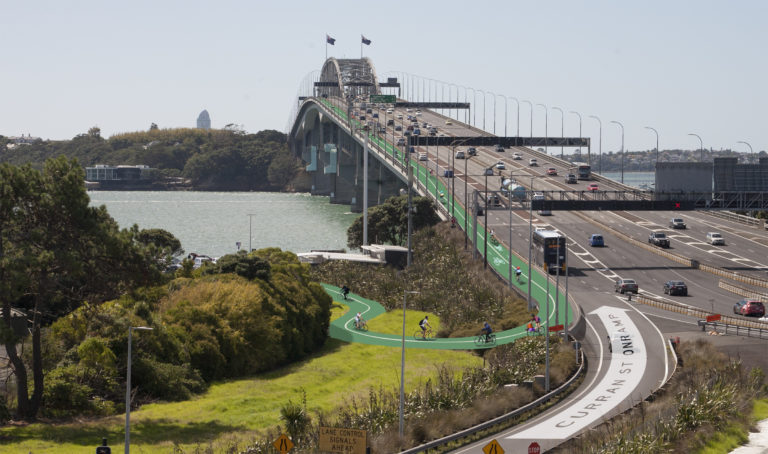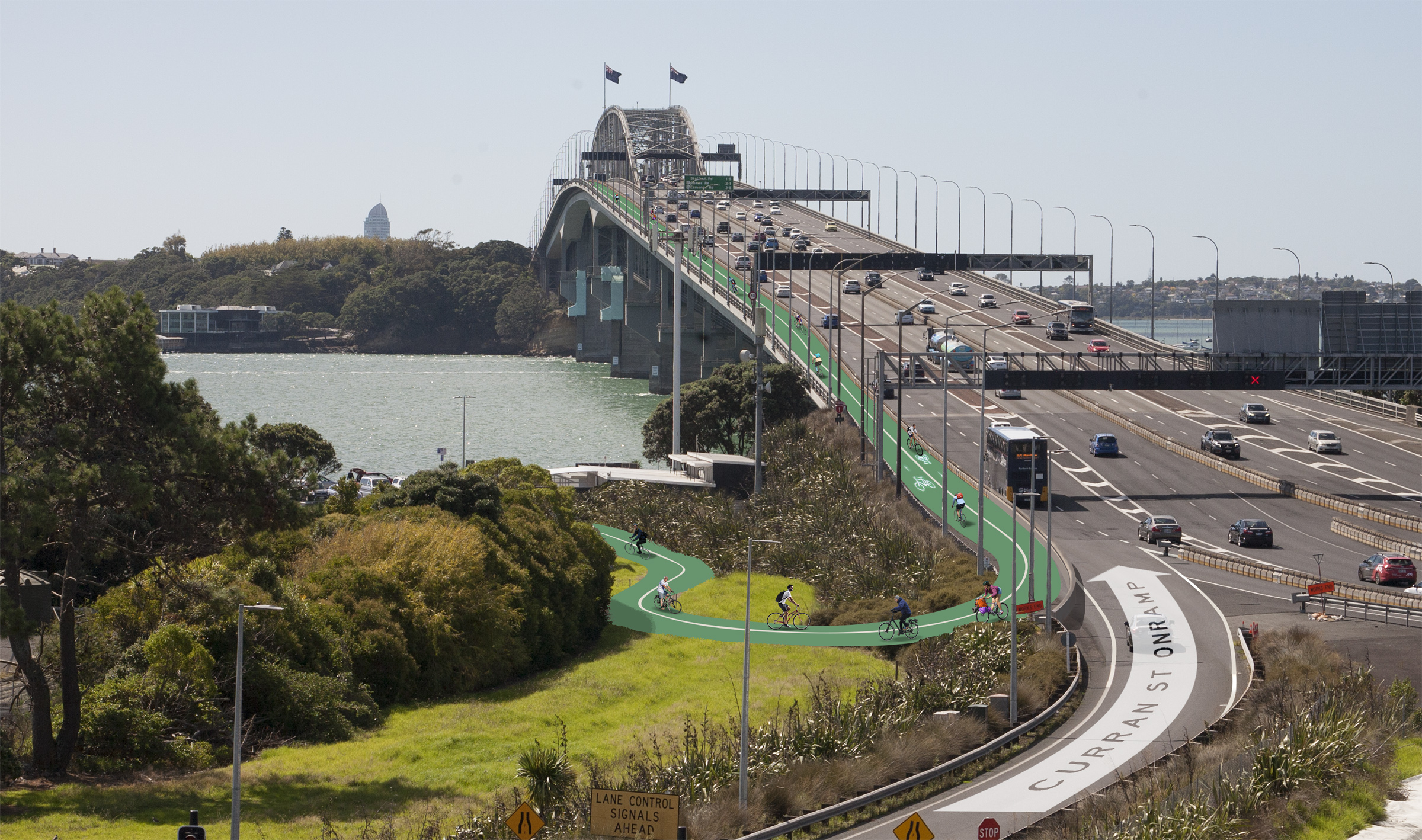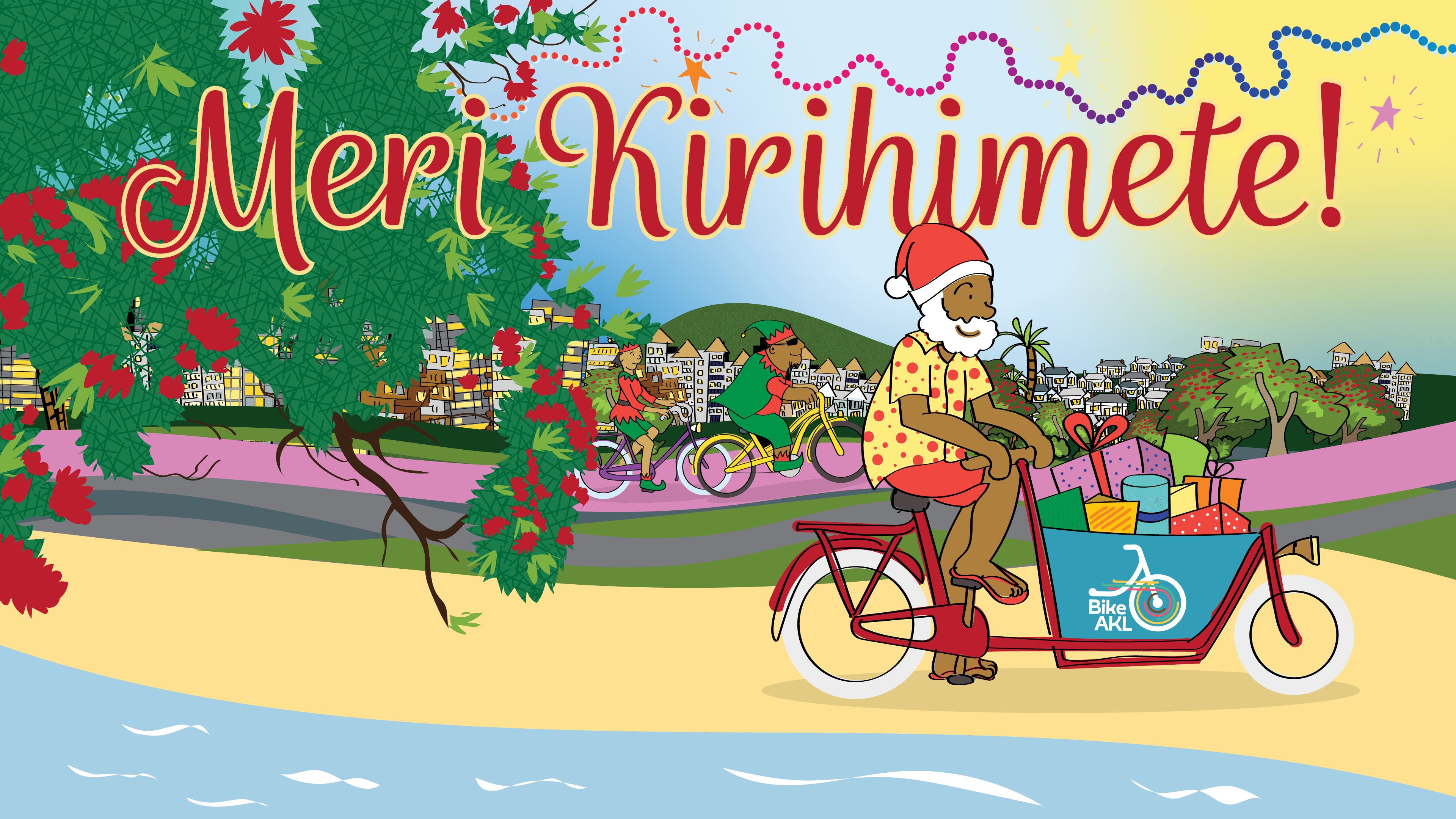We are working with Fullers and AT to help accommodate growing demand to carry bikes on ferries from destinations across the Shore, but it’s clear more capacity is needed. While the Skypath project is stalled, it could be 5+ years before a replacement project is completed. In the interim, new options need to be investigated. Join our rally on May 30th!
We are proposing a three month trial reallocation of one lane on the Auckland Harbour Bridge for cycling this summer. We’re aware there are questions about how this could work and what it would mean for Auckland, so we’re answering the most frequently asked queries here.
Won’t this cause bigger traffic jams?
No. Auckland Harbour Bridge isn’t operating at capacity, and traffic volume has declined since 2017. Enabling more transport choices for crossing the Waitematā Harbour will encourage many to swap from the car to cycling, reducing wider-network congestion. Many people will adjust their travel patterns, and we will all enjoy the results.
That doesn’t make sense. How is it possible?
Traffic expands and contracts to capacity because people adapt. Add a traffic lane on a busy motorway and, relatively quickly, it becomes congested again.
In past years we have focused on building infrastructure for more people to drive, and that’s the result we’ve achieved, more trips by car. Reallocate a lane for cycling, and congestion stays similar to before – but now there’s a way to get around that traffic jam by bike.
Birkenhead to Parnell, for instance, would take less than 30 minutes by e-bike – a faster journey than the same route by car in peak times or heavy traffic. Every bike making that journey relieves traffic, not only on the bridge, but also all the way along Onewa Road, the motorway approach at Northcote point, through Spaghetti Junction and up Parnell Rise. With fewer private motor vehicles on the wider network, those who need to drive will experience shorter overall journey times.
— Prof Ray Wills (@ProfRayWills) April 25, 2021
Has this been done before?
Yes, in many places overseas and even right here in Auckland.
In a meta study of over 70 road reallocation projects across 11 countries, researchers concluded that “significant reductions in overall traffic levels can occur, with people making a far wider range of behavioural responses than has traditionally been assumed.”
On Ian Mckinnon Drive in the central city, a lane was converted into a protected cycle path, with no negative impact on traffic flows – and a huge resultant increase in micro mobility ridership to the city. If everyone who bikes the Northwestern Cycleway were to drive to the central city, traffic congestion would be much worse and the intersection would be gridlocked.
Build it and they will come. Separated cycle paths along all arterial routes is the bare minimum we should expect from our transport authorities – and yes, they do get used. @BikeAKL #AKLBikeLife pic.twitter.com/jv0epeGZg1
— Critical_Ass (@CriticalMassAKL) April 13, 2021
Isn’t it too windy?
During Skypath’s design, discussions with Waka Kotahi (NZTA) indicated that for the overwhelming part of the year, wind won’t be a problem. This is backed by NIWA data on Auckland’s climate which suggests there are only 3-7 days per year when wind speeds on the Auckland Harbour Bridge are such that riding across could be unsafe. This is already the case for heavy freight vehicles crossing the Bridge.
What about the fumes?
Cycling on the bridge will expose you to less emissions than walking on many busy urban streets, where vehicle fumes are trapped between buildings.
Research shows that drivers are generally exposed to more air pollution than people travelling by other modes during their commutes. A 2011 NZTA report concluded “car commuters were overwhelmingly seen to be exposed to higher concentrations of total air pollutants than those who walk, cycle or use public transport.”
And of course moving people out of cars will help improve air quality for everyone, including those in the central city, which frequently records poor air quality results.
Will enough people ride across the bridge to justify it?
Plenty will – 60% of Aucklanders say they would give cycling a go if safe infrastructure was available. For the last ten years the question we are most commonly asked has been “when will I be able to cycle over the bridge?”
In the last round of public consultation on walking and cycling across the harbour, 78% of respondents were in support of the project. 2018 Census data suggests as many as 80,000 trips per day are made across the harbour to locations which are within easy biking distance, and research shows us that many Aucklanders already own a bike.
With work on Northern Corridor Improvements well underway providing a cycle superhighway through the North Shore and bike sales continuing to soar, the Harbour Bridge is a critical missing link in the micro-mobility network. The same applies to the cycling connection along SH1 from Constellation Drive to the Bridge.
Demand for the crossing is extremely high primarily for commuters but also tourists and leisure riders. The link has been missing since the Bridge was first planned and needs to be fixed.
Is the bridge strong enough?
Moving vehicles off one lane and replacing it with people on light bikes means the bridge will see less wear and tear. While Waka Kotahi have given us no reason to believe the bridge clip- ons will need replacing any time soon, reallocating a lane to active transport should extend the life of the bridge.
Can’t we just wait for a new crossing to be built?
After years of dragging the chain to secure active transport access across the harbour, Waka Kotahi have left us with no other option. We need transport choice now. Auckland Council is committed to the C40 Leadership Standards, which state that “In 2024, [Auckland] remains on track to deliver its climate action plan, contributing to increased resilience, equitable outcomes and halving C40’s overall emissions by 2030”.
It’s unlikely that any new bridge structure will be completed before 2030, so we need an interim solution.
Will it be safe?
Yes. Any design for cycling across the harbour bridge will include appropriate crash barriers and fencing in order to keep all bridge users safe. With this in place, the biggest risk will be people enjoying too many spectacular views, fresh air and exercise!
Bridges all over the world have walking and cycling paths that are comparable to our proposal, and these have worked safely for many years and even decades.
Who will pay for it?
Under the NZ Upgrade Programme, central government has already allocated $360 million for a walking and cycling link across the harbour – with that budget set to rise if the Transport Minister announces a new harbour crossing plan.
A temporary reallocation of existing road space might be implemented for less than 1% of that budget, and could be completed quickly – providing the enormous economic benefits of active transport from as soon as the end of this year.
The real question is: Who will pay if we don’t do this?
We all will. Transport is the largest source of CO2 emissions in the Auckland region, and cars literally maim and kill, in multiple ways. The cost of inaction is high – the habitability of the planet and the livelihoods of our tangata need to take priority. When these factors are given the importance they deserve, the idea to trial a cycle lane isn’t in the least bit controversial – it’s essential.
See you at the rally.





